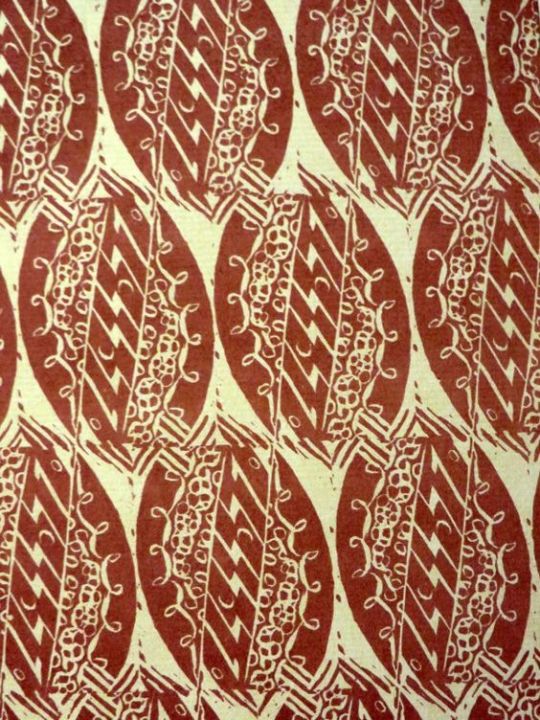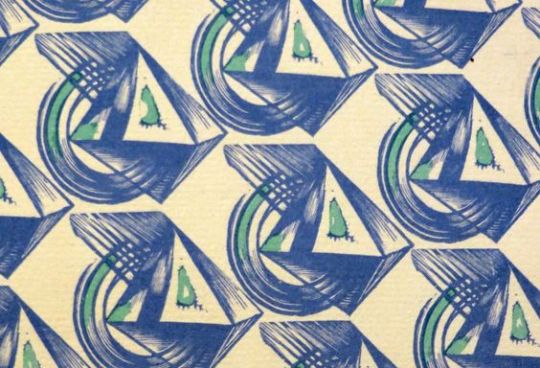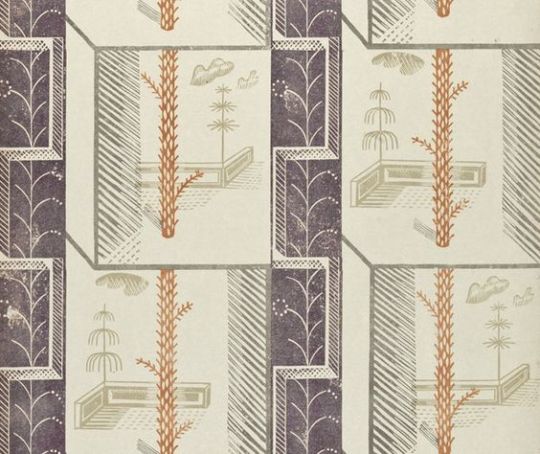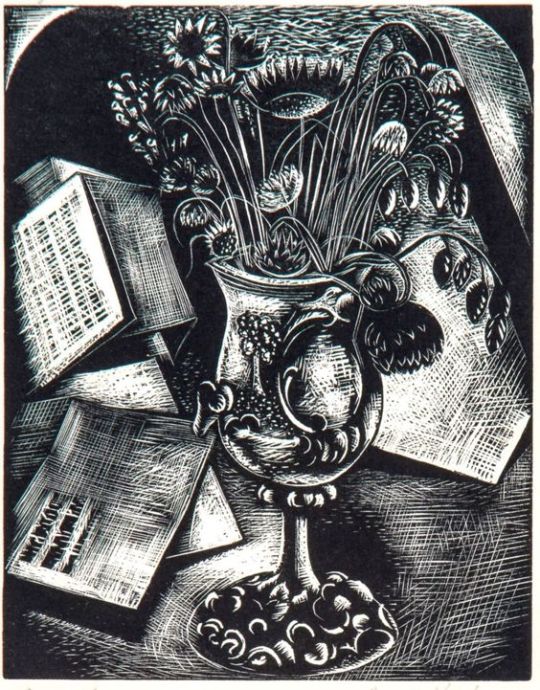An essay from The Woodcut No.1 An Annual.
In its beginning engraving had certain practical uses. One of these was the cutting of hieroglyphics on wooden stamps for the purpose of producing impressions on clay. The cuts were made both in intaglio and in relief. Blocks of this kind, for stamping bricks, where employed by the Egyptians and in Babylon. The accompanying illustration represents a wooden block found in a tomb at Thebes.

Considering these examples of an early method of printing, it is obvious that it was used in other directions, and the inference is that blocks were cut not only with a directly useful intention, as for impressing clay and similar substances, but with a decorative purpose in marking cloth. From the moment the simple craft flowed over from its utilitarian groove it assumed the nature of an art.
That is not to deny that the craft of cutting hieroglyphics may produce consummate art, but a skilled craftsman is not of necessity an artist. Therefore, I date the birth of the art of engraving on wood from the time the craft developed a consciously decorative purpose, and the first-fruits of this were probably in the nature of patterns marked by dyes upon cloth.
It was not until centuries later that the art took on a pictorial significance: even then, for many years after its application to books as an accompaniment to text, its decorative or pattern value was still its true importance. With the increase of skill, however, this quality began to diminish.
The discovery of chiaroscuro only hastened its disappearance, and once the conception of wood engraving as a means for reproducing drawings rather than creating prints was firmly rooted, the decorative value of woodcuts became a matter of accident, dependent, indeed, upon the nature of the drawing translated. Thus, although the art of engraving was already doomed, its spirit has perished long before its ultimate decay into a job for skilled mechanical hacks.
With the revival of wood engraving in recent times, artists have instinctively explored the decorative possibilities of the art. This is only natural in an age interested in the rediscovery of the fundamentals of aesthetics. The woodcut re-seen as an end in itself, and not a means to some other end, discovers itself as a very pure form of art, with its sculptural character, its simple expression in black and white, its direct technique and straightforward application. Of all the arts which are crafts it is the most autobiographical. Indeed, if one may account for the abuse of wood engraving for commercial reasons, it is still difficult to understand the neglect it has received as a means of self-expression. But there is always the dangerous seduction of skillfulness to be taken into account. Hitherto this has been a temptation mainly for the craftsman. To-day it is likely to prove the artist’s snare.

Block Print engraved by Doris Scull
Because, as an engraver, I fear such a danger invading the art I practise I have become lately more interested in woodcut patterns than in woodcut pictures. It is always a relief to be rid responsibility of representation. To concern oneself solely with the problem of formal relationships is to escape into a new world. Here one is in touch with pure reality, and the business of make-believe gives place to other considerations in many ways infinitely more satisfying. I would maintain this about all forms of plastic art, but I feel it to be acutely applicable to engraving on wood. Wood seams to yield to the evolution of an abstract design or a decorative arabesque as stone excites the sculptor to the creation of pure form. For it is the glyptic character of engraving on wood which is its peculiar charm, so that the more the engraver cuts into his block — I do not mean literally in point of depth, in the fractions of an inch — the greater his sense of contact with the reality of his expression.
Unfortunately, the scope of this article may not be extended to a consideration of abstract design as expressed in wood engraving, rather it mush be confined to a cursory examination of a few instances of pattern making by means of wood blocks as practised to-day in England.

Design and cut on wood by Enid Marx for The Curwen Press
The artist who has worked most consistently and successfully in this direction is Miss Phyllis Barron, who for many years now has produced block-printed materials for dresses and furnishing, using a narrow range of carefully chosen and tested dyes of rather sober but subtle colours on linen, cotton, silk and velvet. Miss Barron, being a true artist as well as a crafts-woman, has created something very definite: in my opinion, as valuable as any contribution to contemporary art in this country. With her are working Miss Dorothy Larcher and Miss Enid Marx. The former is a design of equal ability with Miss Barron, with a personal invention distinguishing all her output. Miss Marx, in one sense, is hardly more than a recruit, but judging by her first efforts one may predict a most interesting future for her art. In the first place she is attempting in her patterns a three-dimensional design.
This is a expedient often resorted by the French with amusing results, but our own textile designers seem generally content with the flat arabesque. Miss Marx’s designs have the character of a fugue in music. Another quality which distinguishes them from the majority of textile designs is the peculiarly rigid movement of the units, which are not conceived in fluid waves or undulations, or as an efflorescence, but are more like the delicate architecture of birds, building with rather awkward shaped sticks.

Design and cut on wood by Eric Ravilious for The Curwen Press
It is difficult to proceed farther in discussing the making of patterns without confessing that they are not all cut on wood. Wood is rapidly becoming supplanted by linoleum, and there is no doubt the latter substance has many advantages for the hand block printer. It is quicker and easier to cut, easily replaced, and there is not the danger of warping, which the wood block so constantly presents. Its disadvantages is its unpleasant pulpy texture, which does not allow of fine engraving, and at the same time is a little too easy to cut. There is however, so much excellent work being done in this medium that is must be recognised here.
The most recent group of designers and engravers on linoleum for producing textile patterns is that established by the energy and resource of Mrs. Eric Kennington (nee Edith Celandine Cecil), in a workshop by the river at Hammersmith. The chief craftswoman here is Mrs. Gwen Pike, a most experienced and able engraver and printer. The works, known as Footprints, reproduce patterns by their own staff, and also designs contributed by independent artists.
Finally, there remain to be considered two new fields of activity for the woodcutter. These are the making of wallpapers and papers for book covers by means of printed blocks, These has been recently a revival of interest in wallpapers, especially in Paris, Such distinguished artists as Madame Marie Laurencin and Monsieur Dufy have been in demand, and produced some charming designs. No doubt there are other artists who should be mentioned, but their omission is due to my ignorance, not my neglect.

Raoul Dufy — La Chasse (The Hunt) c1910
In England I am aware of only one designer who has turned his attention seriously to engraving wallpaper patterns. This is Edward Bawden, whose invention in this direction has produced papers of real distinction and originality. I need scarcely add that they have either been ignored or rejected by every manufacturer who has seen them.

Node: Linocut. One of the four ‘Plaistow Wallpapers’ designs commissioned by Curwen Press in 1932
In the narrower field of book cover patterns designers are more fortunate, since there is not only greater demand for ‘original’ papers, but the cost of production is small. Also we have at least one or who enlightened Presses in this country, although our manufacturers remain benighted. Even so, the industry is minute.
Compared with the production of patterned papers on the Continent, more especially in Germany and Austria, the English output is confined to the work produced by the enterprise of the Curwen Press, which continues doggedly to give encouragement to the two or three artists interested in this branch of design. Alas” that is our trouble in England — the general lack of intelligent encouragement given to her artists for any form of activity, small or great, outside of picture-making.
In England we are still prone to cling rather sentimentally to the idea of the Fine Arts, and think it is a little undignified, or at least unusual, for artists to concern themselves with anything but painting and sculpture, with the result that, for the most part, such arts as interior decoration, stained-glass work, theatre décor and textile designing are left in the hands of the competent but uninspired. The British contribution to the Paris Decorative Arts Exhibition was a shocking enough reminder of this fact, and may serve, perhaps, for as good a reason as any why we should begin to consider patterns as important as pictures.
Paul Nash. 1927

Paul Nash: Woodcut — ‘Bouquet’, 1927
It is important to mention that the bold praise of the Curwen press was due to Paul Nash being the head printer there for some years, and this essay being printed by the Curwen Press in 1927. This is not to say there were not ahead of the other printers and designers, but it is always important to review essays with any bias that seeps in the ink.